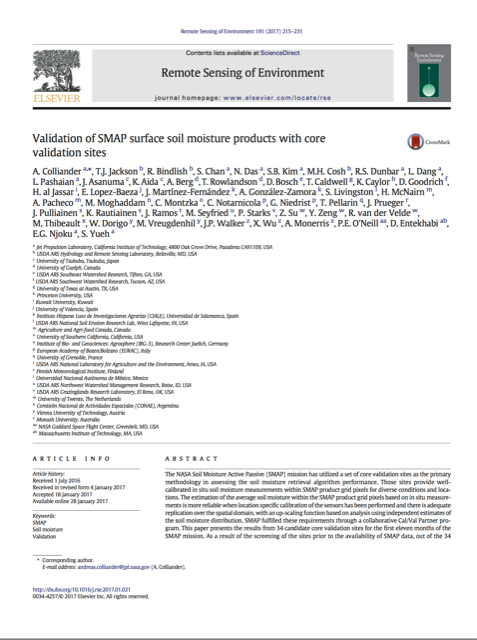Validation of SMAP surface soil moisture products with core validation sites

Colliander, A., et al. (2017) “Validation of SMAP surface soil moisture products with core validation sites”, Remote Sensing of Environment, doi:10.1016/ j.rse.2017.01.021.
Abstract:The NASA Soil Moisture Active Passive (SMAP) mission has utilized a set of core validation sites as the primary methodology in assessing the soil moisture retrieval algorithm performance. Those sites provide well calibrated in situ soil moisture measurements within SMAP product grid pixels for diverse conditions and locations. The estimation of the average soil moisture within the SMAP product grid pixels based on in situ measurements is more reliable when location specific calibration of the sensors has been performed and there is adequate replication over the spatial domain, with an up-scaling function based on analysis using independent estimates of the soil moisture distribution. SMAP fulfilled these requirements through a collaborative Cal/Val Partner program. This paper presents the results from 34 candidate core validation sites for the first eleven months of the SMAP mission. As a result of the screening of the sites prior to the availability of SMAP data, out of the 34 candidate sites 18 sites fulfilled all the requirements at one of the resolution scales (at least). The rest of the sites are used as secondary information in algorithm evaluation. The results indicate that the SMAP radiometer-based soil moisture data product meets its expected performance of 0.04 m(3)/m(3) volumetric soil moisture (unbiased root mean square error); the combined radar-radiometer product is close to its expected performance of 0.04 m(3)/m(3), and the radar-based product meets its target accuracy of 0.06 m(3)/m(3) (the lengths of the combined and radar-based products are truncated to about 10 weeks because of the SMAP radar failure). Upon completing the intensive Cal/Val phase of the mission the SMAP project will continue to enhance the products in the primary and extended geographic domains, in co-operation with the Cal/Val Partners, by continuing the comparisons over the existing core validation sites and inclusion of candidate sites that can address shortcomings.
